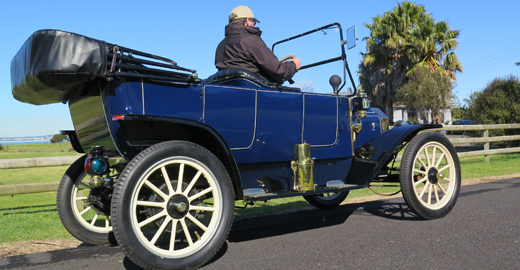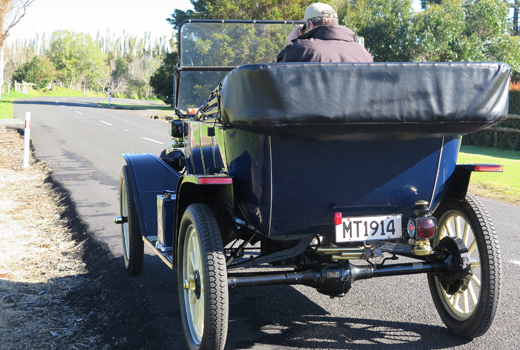Jacqui Madelin on a drive, with time to take in the scenery
There's nothing like an open-topped car to appreciate a sunny winter's day, so I'm glad the top's down on this 1914 Model T.
It's an icon I've not yet encountered this close up, and I have heard it's tricky to drive, though owner Murray Greig says it's a doddle once you're used to it.
He's already primed Annabelle's engine with the front-mounted crank handle and started it. You give it two or three turns to prime the motor, turn the ignition on, set the spark to full retard via a lever on the steering column, set the throttle a quarter open, then - making sure your thumb is on the correct side of the crank handle, or you'll break it - give it another turn to start. Electric starter motors came in in 1918, so he bought and fitted it.
Now with the motor chuggling away, he shows me the "fat man" wheel that flips up to ease a comfortable belly behind it, something he doesn't need but happily illustrates - and then his feet start doing the sedate Model T minuet as we pull away.
The left-hand pedal flat to the floor equals low gear.
Half way is neutral, right out is top. The pedal jammed next to it - he just about has to put his foot sideways to use it - is reverse, and tight up against that is the brake.
"If in doubt, hit all three pedals," he says, cheerily.

Murray Greig appreciates the beautiful simplicity of the Ford Model T.
By now we're barreling through the suburbs en route for a bit of open-road driving.
"They're good for 100km/h, but the trouble is it wouldn't stop. I don't think brakes were one of Henry's priorities - he just wanted to make them go. And sell them."
He says it's happier topping out at 80km/h, so you can keep up with traffic, and he should know. Murray and his wife, Jacky, have driven this car from Auckland to Cape Reinga, and took three days to Christchurch, "I'd drive it all day if I could, they're great fun to drive and it's not like a modern car, you get time to look around you."
It's interesting being able to watch the road pass beneath us through the foot-pedal slots, "At night you can look down and see the hot exhaust glowing."
Not that he drives it much after dark, the acetylene headlights aren't great. The acetylene gas generator is an impressive brass device on the door sill. The bottom holds carbide, Murray pours water in the top and it drops on the carbide, making acetylene to feed the headlights. The other lamps are all kerosene-fuelled and yes, that means all the lights rely on flames to see the road ahead.
"Acetylene blows out more easily and doesn't last as long as kerosene, but it's brighter."
It must look good sparkling on all that brass, which dates the car, as by 1915 there was very little, it was a precious metal during WWI.
Murray's had this T around 15 years, but it's not his first. "I believe in the simplicity of them. You'd hear you can fix them with number eight fencing wire, well that was true."

1914 Ford Model T
This one has no history, it's been built up from parts, all dated at 1914 by the veteran car club, but not all from the same car. He does most of the work himself, bar specialist tasks like upholstery and wheels, and in the process of putting it together - and sourcing bits - he's become a mine of information. "The mirrors started out round but they vibrated too much, so they brought out rectangular ones with weights on the bottom."
The engine's 2200cc, "A slow 2200cc! It's not high performance but it's got torque. We came up that hill in top gear and high ratio on the diff. They don't rev much, they'd shake apart."
We're keeping up with traffic no problem, but pulling away is slightly less brisk - and the Model T is quicker than some. The car's comfy enough, though too bouncy to make notes while driving. It's leaf-sprung, with two transverse springs, and brakes operated via an external band clamping the outside of a drum on the rear wheels.
It sounds dodgy but must work okay, as he drives it every week in summer.
The horn gets the final word. There are two of those because when the car was new, you weren't allowed to use the squeeze-bulb horn on the Ohio prairies as it frightened the farm horses. So the Model T has one under the bonnet, with a valve that opens to release compression through the whistle, and a rather decorative mini-organ-array out back operated by an exhaust flap - quite piercing it is, too, especially from close up, with camera in hand. Thanks for that, Murry.

